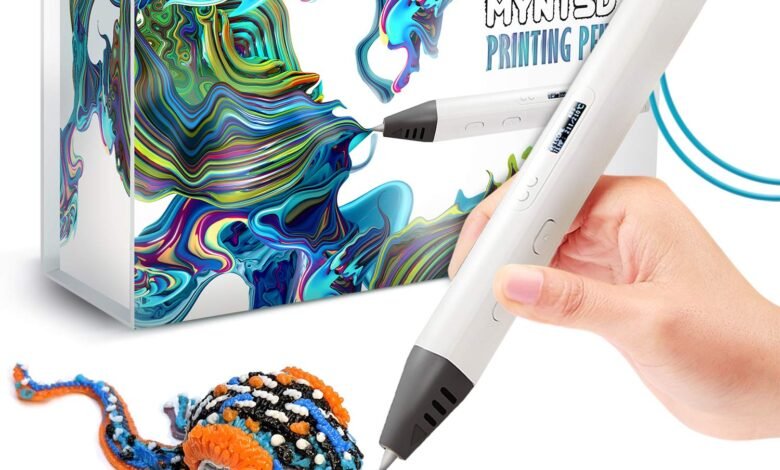Title: The Creative Magic of a 3D Pen: A Game-Changer for Artists, Hobbyists, and Innovators

Introduction: What Exactly is a 3D Pen?
A 3D pen might look like an ordinary chunky marker at first glance, but don’t let its appearance fool you. It’s a powerful tool capable of bringing your sketches to life—literally. Instead of ink, a 3D pen extrudes heated plastic filament that cools and solidifies as it leaves the tip, allowing users to draw in three dimensions. Think of it as a handheld 3D printer, minus the complex software and machinery.
For hobbyists, artists, educators, or even DIY enthusiasts, the 3D pen opens up a whole new world of possibilities. Whether you’re designing intricate sculptures, repairing plastic items, or simply doodling in midair, a 3D pen offers a unique, hands-on creative experience. It’s no longer just a niche toy; it has become a tool of genuine innovation.
These pens are especially attractive because they’re user-friendly. You don’t need technical expertise or expensive CAD programs to get started. Just plug it in, insert the filament, and draw. It’s that simple—and that amazing.
How Does a 3D Pen Work?
Understanding how a 3D pen works is crucial to appreciating its full potential. At its core, the pen contains a heating element that melts plastic filament—typically PLA or ABS. Once heated to a specific temperature, the plastic becomes soft and can be pushed through the nozzle as you draw. The moment it exits, it begins to cool and solidify, holding its shape almost instantly.
Most modern 3D pens allow for temperature and speed adjustments. That means you can fine-tune the flow depending on your project. Working on something delicate? Slow it down. Building a large structure? Crank it up. This level of control helps you work more efficiently and produce cleaner results.
There are also two primary types of 3D pens on the market: filament-based pens and resin-based pens. The filament version is more common and beginner-friendly, while resin pens, which cure liquid resin using UV light, offer greater detail but are a bit more advanced. Regardless of the type, the principle remains the same: layer by layer, you’re creating three-dimensional objects freehand.
Why the 3D Pen is a Must-Have Tool for Creatives
For artists and designers, a 3D pen isn’t just a gadget—it’s a new medium. Traditional drawing is limited to flat surfaces, but 3D pens break that barrier. You can literally “draw” upward and create structures that defy conventional artistic boundaries. Want to sketch a bird and make its wings pop out? Go ahead. Feel like creating a life-sized spider web as Halloween decor? Totally doable.
Beyond pure art, 3D pens are also revolutionizing the world of fashion and design. Designers are experimenting with wearable art made entirely from 3D pen filaments. Think accessories, jewelry, and even parts of clothing. These creations are not just showpieces—they’re durable, functional, and stylish.
Moreover, for those who like to tinker or fix things around the house, a 3D pen can also act as a handy repair tool. Cracked plastic phone case? Broken drawer handle? You can easily fill gaps or rebuild small plastic parts. It’s like having a tiny welding machine for plastic—versatile, compact, and satisfying to use.
Educational Benefits: Learning Through Creation
3D pens are also making waves in the education sector. Teachers and educators are using them to bring lessons to life in ways textbooks simply can’t match. Imagine learning about geometry by drawing actual 3D shapes or studying human anatomy by building organs layer by layer. The tactile nature of 3D pens makes them especially useful for visual and kinesthetic learners.
STEM (Science, Technology, Engineering, and Math) programs in particular have embraced this technology. Students use 3D pens to create models, prototypes, and even basic machines. It bridges the gap between theoretical learning and hands-on application. This can dramatically enhance student engagement and deepen understanding of complex concepts.
Even in early education, 3D pens are finding a role. Children can develop fine motor skills, spatial reasoning, and creativity all while having fun. Since many pens are now made with safety features and non-toxic filaments, they’re perfectly suitable for younger users (with supervision, of course).
Tips for Getting Started with Your First 3D Pen
If you’re new to the world of 3D pens, don’t worry—you don’t need to be a seasoned artist to enjoy them. The key is to start simple and gradually build your skills. Begin with 2D outlines on stencils, then slowly try connecting those shapes to form 3D structures. Over time, your muscle memory and creative instincts will develop.
Choose the right filament. PLA is great for beginners—it’s biodegradable, easy to use, and doesn’t emit unpleasant fumes. ABS, on the other hand, is more durable but requires higher temperatures and proper ventilation. Always follow the manufacturer’s guidelines to avoid damaging your pen or injuring yourself.
It’s also worth investing in a few accessories. A heat-resistant mat will protect your workspace, and a filament organizer will keep your materials tangle-free. Don’t forget to clean your pen regularly to avoid clogs and prolong its lifespan. Lastly, browse community platforms like Pinterest or Reddit for free templates and inspiration—it’s amazing what people are creating!
Popular Uses of 3D Pens in Everyday Life
You might think a 3D pen is only good for art projects, but its uses go far beyond that. Many people use 3D pens for home improvement tasks—patching up broken items, customizing furniture, or even making decorative wall art. It’s a blend of utility and artistry.
In the world of cosplay, 3D pens are a game-changer. Cosplayers are using them to build lightweight armor, weapons, and intricate costume details. Instead of relying on expensive mold-making techniques, creators can draw their designs directly onto foam or fabric. It’s quicker, more affordable, and completely customizable.
Makers and engineers also use 3D pens for prototyping. Need to test a joint or connector before printing a full 3D model? A 3D pen allows for quick mockups without the wait time of a traditional 3D printer. It’s a practical tool for brainstorming and problem-solving on the fly.
Final Thoughts: Is a 3D Pen Worth It?
Absolutely, yes. Whether you’re a seasoned artist, a curious student, or just someone who likes to try new things, a 3D pen offers a unique blend of fun and functionality. It’s one of those rare tools that blurs the line between creativity and utility—one moment you’re building a sculpture, and the next you’re fixing your broken sunglasses.
As technology continues to evolve, 3D pens are becoming more affordable, efficient, and user-friendly. You don’t need to spend a fortune to get a high-quality pen that performs well. Just a little bit of patience, a steady hand, and an active imagination can take you far.
So if you’ve been on the fence about getting a 3D pen, consider this your sign. Pick one up, load some filament, and start drawing your ideas into existence—one layer at a time. The only limit is your creativity.



